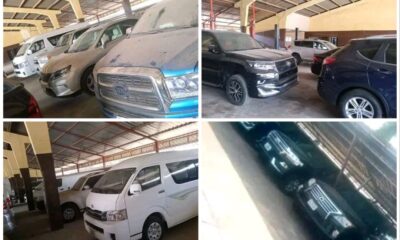News
5 Warning Lights You Should Never Ignore In Your Car!
Published
7 years agoon
If you have a car that drives you daily and you don’t jump on danfo and other commercial cars, then consider yourself lucky and favored, however, If any of the above warning lights come on while you are driving, DO NOT IGNORE THEM! Immediate action may be necessary to prevent damage to your vehicle, a breakdown or an accident.
OIL PRESSURE WARNING LIGHT
The oil pressure warning light comes on if your engine has lost oil pressure or oil pressure is too low for safe engine operation. You should pull over to the side of the road, shut the engine off and check the oil level on the engine dipstick.
Possible Causes: Low oil level (due to oil consumption or leaks), oil viscosity too thin, worn oil pump, excessive engine bearing clearances or defective oil pressure sending unit.
If you engine is also making ticking, clattering or rapping noises, it is not getting sufficient oil. If you attempt to drive the engine in this condition, you will probably damage it – if it hasn’t already suffered major internal damage.
TEMPERATURE WARNING LIGHT
The temperature warning light will come on if your engine is overheating. Do NOT continue driving if your engine is overheating as this can cause expensive engine damage (piston scuffing, valve stem galling, failed head gasket, cracks or distortion in cylinder head). Stop driving, pull over and shut your engine off. Open the hood and check the radiator and heater hoses, radiator and engine for coolant leaks. Note the level of the coolant in the coolant reservoir.
CAUTION: DO NOT open the coolant reservoir or radiator cap until the engine has cooled off for at least 30 minutes. Steam pressure inside the cooling system can blow out and burn you!
If the coolant level is low, add coolant (a 50/50 mixture of antifreeze and clean distilled water) after the engine has cooled down.
Possible Causes: Low coolant level (due to coolant leak or bad head gasket), stuck thermostat, bad water pump, broken serpentine belt, defective radiator cooling fan, clogged or dirty radiator, exhaust restriction (plugged catalytic converter).
HINT: Turning the A/C OFF and turning the heater on HIGH may help cool down an engine that is temporarily overheating due to unusually hot weather or from towing a trailer. But if the engine is running hot because it is low on coolant, this trick probably won’t help much.
CHARGING SYSTEM WARNING LIGHT
The “GEN” or “ALT” warning light, or an icon of a battery will illuminate if the charging voltage in your vehicle is low. You do not have to stop immediately, but you may only have 20 to 30 minutes of driving time before your battery goes dead and your engine stops running (or even less time if you are driving at night with your headlights on).
Possible Causes: Broken or slipping serpentine belt or V-belt, bad alternator, charging control fault, or loose or corroded battery cables.
Open the hood to see if the drive belt that turns the alternator is intact and is turning the alternator while the engine is idling. If the belt is not the problem, chances are the charging system has a problem that will have to be diagnosed and repaired. Better find a repair shop soon!
BRAKE WARNING LIGHT
The Brake Warning light will come on if the parking brake has not been fully released, but it may also come on if the brake fluid level is low or there has been a loss of hydraulic pressure in one of your car’s brake circuits. Loss of fluid or brake pressure means the brakes may not be able to stop your car when you step on the pedal.
Carefully apply the brakes to see if they are working. If they are, pull over to the side of the road, open the hood and check the fluid level in the brake master cylinder. If the fluid level is low, the brake system should be inspected for leaks. If there are leaks, your brake system is unsafe to drive.
If the brake pedal is low or goes to the floor, pumping the pedal may apply enough pressure to stop your car. If that fails, apply your parking brake to slow your vehicle. Also, take your foot off the gas and shift to neutral, or downshift and use engine braking to slow your vehicle if you have a manual transmission. If all that fails, aim for something soft like a bush or open field.
Possible Causes: Loss of brake fluid due to leaks (master cylinder, calipers, wheel cylinders, brake lines or hoses), failure of the pressure differential switch that activates the brake light, parking brake pedal or handle not fully releasing, defective parking brake switch.
WARNING: If the brake pedal feels soft, is low, goes to the floor, or you have to pump the pedal to get your vehicle to stop, your vehicle is unsafe to drive. You should have it towed to a repair facility for repairs.
LOW TIRE WARNING LIGHT
The Low Tire Pressure Warning Light will come on if any tire on your vehicle is 25 percent or more under-inflated. Driving on a low tire can be dangerous because it increases the risk of a tire blowout. A low tire can also cause uneven braking, uneven traction, uneven and rapid tire wear, increased rolling resistance and fuel consumption.
Find a filling station with an air pump, and check the inflation pressure in each tire with an accurate gauge (not the gauge on the pump, which is often very inaccurate!). Add air as needed to inflate your tires to the recommended pressure (see your owners manual or the tire inflation decal in the door jam or glove box). For most passenger cars, the recommended pressure is typically 32 to 34 PSI.
Possible Causes: Loss of air pressure due to a leak (such as a nail or small puncture in a tire, or a bad valve stem), loss of air pressure due to seepage (1 to 2 PSI per month loss is normal for many tires), or inaccurate or failing TPMS sensor in tire.
Checking your tires regularly (at least once a month or before any long road trip) is recommended. Check the tires when they are COLD and BEFORE you drive your vehicle as driving creates friction and heats up the tires (causing an increase in air pressure).
AutoReportNG is your one-stop place for quality news on roads, cars, and anything pertaining to mobility. We keep track of all current news in road, rails, and aviation. We are known to true, factual and investigative news.

You may like
-


Crosser V1 Amphibious Mobility System by Bernardo Pereira
-


Hyundai Ioniq 7 Three Row Electric SUV Set To Debut In Summer
-


DIY Car Repairs: Common Issues Faced by Lagos Car Owners
-


Black Box Becomes Compulsory For All New Cars In Europe From July
-


Benue Asset Committee Recovers 48 Vehicles, Say Only One Person Has Come With Documents
-


Mercedes-Benz Vision One-Eleven Iconic Luxury Inspired by The ’70s Experimental Vehicle







1 Comment
You must be logged in to post a comment Login